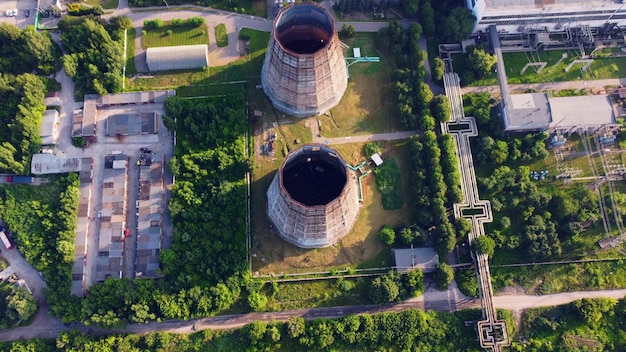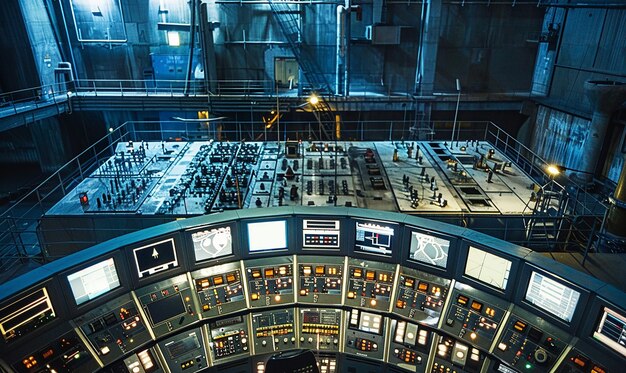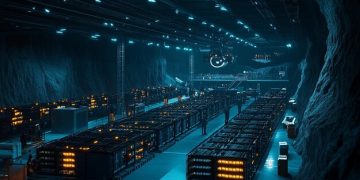Nuclear Energy: Viable Solution for US Energy Crisis?

The debate is intensifying on whether nuclear energy is a viable and necessary solution for the US energy crisis, with proponents highlighting its carbon-free nature and critics raising concerns about safety, waste disposal, and cost.
The question, Debate Heats Up: Is Nuclear Energy a Viable Solution for the US Energy Crisis?, is more pertinent than ever. As the United States grapples with volatile energy markets, geopolitical uncertainties, and the pressing imperative of climate change, the conversation around nuclear power has been rekindled with renewed fervor. Is this long-debated technology finally positioned to be a cornerstone of America’s energy future?
The US Energy Landscape: A Complex Challenge
The United States energy landscape is a tapestry woven from diverse sources, consumer demands, and intricate geopolitical threads. For decades, fossil fuels have dominated, providing the backbone of industrial growth and everyday life. However, this reliance has come with increasing environmental costs and supply vulnerabilities. The pursuit of energy independence, coupled with the urgent need to decarbonize the economy, has propelled alternative sources to the forefront of national dialogue.
The energy crisis itself is multifaceted. It stems from a combination of fluctuating global supply chains, geopolitical tensions impacting oil and gas prices, and the growing demand for electricity driven by population growth and technological advancements. Moreover, the aging infrastructure of the existing grid poses significant challenges, leading to reliability concerns and susceptibility to extreme weather events. This intricate web of factors necessitates a comprehensive and forward-thinking approach to energy planning.
The Push for Decarbonization
A primary driver behind the renewed interest in nuclear energy is the global push for decarbonization. Climate change, fueled by greenhouse gas emissions, demands a drastic reduction in carbon footprints across all sectors, especially energy. Nuclear energy offers a significant advantage in this regard.
- Zero-emission operation: Nuclear power plants produce electricity without emitting greenhouse gases during operation.
- Reliable baseload power: Unlike intermittent renewables such as solar and wind, nuclear plants can operate continuously, providing a stable power supply.
- Reduced air pollution: Beyond carbon, nuclear energy avoids releasing pollutants that contribute to smog and acid rain.
This inherent characteristic makes nuclear power an attractive option for countries committed to meeting ambitious climate targets while ensuring a stable and abundant energy supply. The challenge lies in balancing its carbon benefits with other critical considerations.
Nuclear Energy Explained: How It Works
Nuclear energy fundamentally harnesses the power released from splitting atoms in a process called nuclear fission. This process occurs in specialized facilities known as nuclear power plants, which are engineered to safely control and utilize this immense energy. Understanding the basic mechanics is crucial to appreciating its potential and inherent complexities.
At the heart of a nuclear power plant is the reactor core, where uranium fuel rods are subjected to a controlled chain reaction. When a neutron strikes a uranium atom, it splits, releasing immense heat and more neutrons, which in turn split other atoms. This chain reaction is carefully managed using control rods that absorb excess neutrons, preventing an uncontrolled meltdown. The heat generated converts water into high-pressure steam, which then drives turbines connected to generators, producing electricity.
Types of Nuclear Reactors
While the core principle remains fission, various reactor designs have emerged over the decades, each with its own advantages and challenges. The most common type is the Light Water Reactor (LWR), which uses ordinary water as both a coolant and a neutron moderator.
- Pressurized Water Reactors (PWRs): These operate at high pressure, preventing water from boiling within the reactor core, using a secondary loop to generate steam.
- Boiling Water Reactors (BWRs): In BWRs, water boils directly within the reactor vessel, producing steam that drives the turbine.
- Small Modular Reactors (SMRs): A newer concept, SMRs are advanced nuclear reactors that are smaller, modular, and can be mass-produced, potentially reducing construction costs and timelines.
The transition towards more advanced and safer reactor designs, such as SMRs, is seen by many as a potential game-changer for nuclear energy’s future. These designs aim to address some of the historical drawbacks, including high upfront costs and lengthy construction periods, while enhancing safety features. The hope is that SMRs could allow for more flexible deployment and easier integration into existing energy grids.
Arguments For: Why Nuclear Should Be a Go
Proponents of nuclear energy present a compelling case for its inclusion as a major component of the US energy portfolio. Their arguments hinge on several key benefits that address both environmental imperatives and energy security concerns. The ability of nuclear plants to produce significant amounts of electricity without emitting greenhouse gases is a cornerstone of this advocacy.
Nuclear power plants boast an exceptionally high capacity factor, meaning they operate at maximum power for a much larger percentage of the time compared to most other energy sources. This makes them highly reliable for providing baseload power, which is the minimum amount of electric power delivered or required over a given period. This reliability contributes significantly to grid stability and energy security, reducing dependence on volatile fossil fuel markets.

Energy Independence and Security
One of the most powerful arguments for nuclear energy is its contribution to national energy independence and security. Unlike oil and natural gas, which are often subject to international geopolitical forces and price fluctuations, uranium fuel can be sourced from a variety of stable nations or stockpiled.
- Diversified fuel sources: Uranium is abundant globally, and the US has domestic reserves.
- Reduced reliance on imports: Less dependence on foreign fossil fuels stabilizes the energy supply.
- Stable operations: Once fueled, nuclear plants can operate for extended periods, providing consistent power without disruption.
This stability translates into a more predictable and resilient energy grid, less susceptible to global crises or supply chain disruptions. In an era where energy is increasingly seen as a geopolitical tool, enhancing domestic nuclear capacity bolsters national security.
Environmental Benefits
Beyond the absence of greenhouse gas emissions during operation, nuclear energy offers other critical environmental advantages. Its minimal land footprint relative to the enormous amount of energy it produces is a significant consideration, especially in densely populated areas.
Compared to large-scale renewable energy projects like solar farms or wind turbine installations, nuclear power plants require considerably less land per unit of electricity generated. This efficiency in land use preserves natural habitats and agricultural areas. Furthermore, nuclear power does not contribute to air pollution in the way fossil fuel burning does, improving air quality and public health outcomes. The long operational lifespan of nuclear plants also means that the initial environmental impact of construction is amortized over many decades, making it a sustainable choice from a resource perspective.
Arguments Against: The Challenges and Concerns
Despite the compelling arguments in its favor, nuclear energy faces significant opposition and poses substantial challenges that must be critically examined. Concerns range from safety and waste disposal to economic viability and public perception. These issues are not easily dismissed and contribute to the ongoing debate about nuclear power’s role.
The specter of nuclear accidents, though rare, looms large in the public consciousness, intensified by events like Chernobyl and Fukushima. While modern reactors incorporate extensive safety protocols and passive safety features, the potential for catastrophic failure, however remote, remains a powerful deterrent for many. This fear is compounded by the challenge of managing radioactive waste, which remains hazardous for thousands of years and currently has no permanent, universally accepted disposal solution.
Safety and Proliferation Risks
Safety is perhaps the most contentious point in the nuclear debate. Critics highlight the extreme consequences of a nuclear meltdown, arguing that no amount of engineering can completely eliminate the risk of human error or natural disaster.
- Accident potential: Though infrequent, meltdowns have devastating environmental and human costs.
- Terrorism concerns: Nuclear facilities and materials could be targets for malicious actors.
- Proliferation of weapons: The technology and materials used for nuclear energy can also be repurposed for nuclear weapons.
The risk of nuclear proliferation, where the technology used for energy purposes is diverted to develop weapons, is a serious international concern. Strict oversight by international bodies like the IAEA (International Atomic Energy Agency) is necessary, but the dual-use nature of nuclear technology presents an inherent challenge. Ensuring robust security at all stages of the fuel cycle is paramount.
Waste Disposal and Cost
The issue of nuclear waste is a massive long-term challenge. Spent nuclear fuel remains highly radioactive for exceptionally long periods, requiring secure containment for millennia.
Currently, most spent fuel is stored in temporary, on-site facilities, either in spent fuel pools or dry casks. A long-term geological repository, such as Yucca Mountain in the US, has been proposed but faces significant political and scientific hurdles, including local opposition and concerns about geological stability. The sheer volume of waste continues to grow, and the absence of a permanent solution places a burden on future generations. Moreover, the economic viability of nuclear power plants is often undercut by their astronomical upfront construction costs and lengthy build times, often running over budget and behind schedule. While operational costs can be low, the initial investment required is immense, making financing a significant barrier and often requiring substantial government subsidies or loan guarantees.
Comparing Nuclear with Other Energy Sources
To properly assess whether nuclear energy is a viable solution, it is essential to compare its attributes with other major energy sources currently available to the US. This comparative analysis reveals nuclear’s unique strengths and weaknesses relative to fossil fuels, solar, wind, and hydropower. Each source plays a role, but their suitability for different aspects of the energy crisis varies.
When stacked against fossil fuels like coal and natural gas, nuclear power stands out for its zero operational carbon emissions, making it a critical tool in the fight against climate change. Unlike fossil fuel plants, nuclear facilities do not emit pollutants into the atmosphere during power generation, contributing to better air quality. However, fossil fuels offer greater fuel flexibility and generally lower upfront capital costs for power plant construction, although they bear the burden of fuel price volatility and carbon capture requirements for future operations.
Renewables: Complement or Competitor?
Renewable energy sources like solar and wind have seen significant growth and cost reductions, becoming increasingly competitive. The question is whether they compete with or complement nuclear power.
- Intermittency of Renewables: Solar and wind power are highly dependent on weather conditions, making their output variable.
- Baseload vs. Intermittent: Nuclear provides stable baseload power, which renewables currently struggle to deliver consistently.
- Land Use Comparisons: While nuclear has a smaller footprint per MWh, large-scale renewable farms require significant land area.
The prevailing view among many energy experts is that nuclear and renewables are complementary. Renewables can handle peak loads and reduce overall fossil fuel consumption, while nuclear ensures grid stability by providing constant, reliable baseload power when solar and wind generation are low. This combination could form a robust, low-carbon energy system, leveraging the strengths of each technology. Battery storage is improving but is not yet capable of seasonal storage on a grid scale, making consistent sources like nuclear indispensable.
Carbon Footprint and Reliability
The carbon footprint is where nuclear power truly shines compared to fossil fuels. Life cycle assessments show that nuclear power’s emissions are comparable to—or even lower than—those of solar and wind energy when factoring in construction, fuel extraction, and decommissioning.
In terms of reliability, nuclear power plants operate with a very high capacity factor, typically above 90%, meaning they are running at full power for more than 90% of the time. This far surpasses the capacity factors of most renewable sources (which typically range from 25-50% for solar and wind) and even many fossil fuel plants. This consistent output is invaluable for maintaining grid stability and meeting continuous energy demands, preventing blackouts and ensuring a steady supply even during peak times or adverse weather conditions. The ability to supply a constant stream of electricity distinguishes nuclear power as a vital component for a modern, robust grid.
The Path Forward: Policy, Innovation, and Public Opinion
Navigating the complex landscape of the US energy crisis and determining nuclear energy’s role requires a multifaceted approach involving supportive policy, continuous technological innovation, and a shift in public perception. These three pillars are interdependent; progress in one often influences the others. Without a concerted effort across these areas, nuclear power’s potential may remain largely untapped.
Policy frameworks need to provide clear, long-term signals to investors, reducing the financial risk associated with nuclear projects. This can include streamlined licensing processes, loan guarantees, and investment tax credits that recognize nuclear’s carbon-free attributes. Alongside policy, innovation is key. The development of Small Modular Reactors (SMRs) and advanced reactor designs promises to address many of the historical criticisms regarding cost, construction time, and safety. These new technologies could represent a paradigm shift in how nuclear power is deployed and perceived.
Addressing Regulatory Hurdles
The regulatory environment for nuclear energy in the US is notoriously complex and time-consuming, often cited as a major barrier to new construction. Streamlining the licensing process while maintaining rigorous safety standards is crucial for accelerating deployment.
- Modernizing regulations: Adapting rules for advanced reactor designs.
- Standardizing designs: Approving fewer, standardized designs could speed up deployment.
- Efficient review processes: Reducing bureaucratic delays without compromising safety.
The Nuclear Regulatory Commission (NRC) plays a pivotal role in this. Efforts to develop risk-informed, performance-based regulations that are more tailored to modern reactor designs could significantly reduce the time and cost associated with licensing. This modernization is essential to making nuclear a more competitive option against other energy sources. The goal is to create a predictable and efficient pathway for new projects while upholding the highest safety and security standards, ensuring that nuclear facilities are both safe and economically viable.
Shaping Public Perception
Public perception is perhaps the most challenging aspect of expanding nuclear energy. Decades of negative connotations, fueled by accidents and waste concerns, have created a significant hurdle. Education and transparent communication are vital.
Engaging communities early in the planning process, providing clear information about safety measures, and transparently addressing waste management plans can help build trust. Highlighting the climate benefits of nuclear power and its role in ensuring energy independence can also shift the narrative. Emphasizing the continuous advancements in safety technology and showcasing the operational safety record of existing plants are crucial. Ultimately, a balanced and factual discourse about the benefits and risks, rather than relying on historical fears, will be necessary to secure public acceptance and support for nuclear energy as a viable solution to the US energy crisis. This includes demonstrating that newer reactor technologies are designed with passive safety features that can shut down without human intervention in an emergency.
| Key Aspect | Brief Description |
|---|---|
| ⚛️ Decarbonization | Nuclear energy offers a carbon-free power source during operation, crucial for climate goals. |
| 🔒 Energy Security | Reduces reliance on volatile fossil fuels, enhancing national energy independence. |
| 🗑️ Waste & Costs | Challenges remain with long-term nuclear waste disposal and high upfront construction costs. |
| 💡 SMR Innovation | Small Modular Reactors (SMRs) promise to address cost and safety concerns, streamlining deployment. |
Frequently Asked Questions About Nuclear Energy
▼
Nuclear energy generation produces virtually no greenhouse gas emissions during operation, making it a critical tool for combating climate change. It also offers a highly reliable and consistent baseload power supply, operating continuously and reducing the grid’s dependence on variable renewable sources like solar and wind, thereby enhancing energy security and stability.
▼
Major concerns include the safe, long-term disposal of radioactive waste, which remains hazardous for thousands of years, and the high upfront capital costs and long construction times for new plants. Public perception is also a challenge due to past accidents, and there are inherent risks associated with safety and potential nuclear proliferation.
▼
SMRs are designed to be smaller, simpler, and more standardized, which aims to reduce construction costs and accelerate deployment timelines. Their modular design allows for factory fabrication and easier transport, potentially making nuclear power more economically viable and quicker to build than conventional large-scale plants. They often incorporate enhanced passive safety features.
▼
Nuclear energy is generally seen as complementary to renewables rather than a direct competitor. While solar and wind are increasingly cost-effective, they are intermittent. Nuclear provides reliable baseload power regardless of weather, ensuring grid stability. A combination of nuclear and renewables offers a robust, low-carbon energy mix that leverages the strengths of both, providing consistent power when renewables are not generating.
▼
Supportive government policies, including streamlined regulations, financial incentives, and clear long-term energy strategies, are crucial to attracting investment and accelerating nuclear project development. Shifting public perception through education and transparent communication about safety, waste management, and climate benefits is equally important for building the broad societal acceptance needed for expanded deployment.

Conclusion
The question of whether nuclear energy is a viable solution for the US energy crisis is not a simple yes or no. It is a nuanced debate with substantial arguments on both sides. The undisputed benefits of nuclear power—its carbon-free operation, high reliability, and contribution to energy independence—offer compelling reasons for its expansion. However, the persistent challenges of waste disposal, high upfront costs, and the shadow of safety concerns demand continued innovation and diligent risk management. As the US navigates its complex energy future, a balanced approach is essential. Integrating new, safer reactor designs, coupled with effective long-term waste solutions and a transparent public dialogue, could position nuclear energy as a vital component of a resilient, sustainable, and diversified national energy portfolio. The path forward is challenging, but the potential rewards in terms of environmental protection and energy security are significant.





